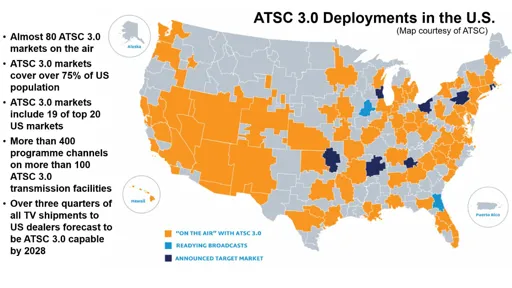
Sam Matheny (National Association of Broadcasters)
The USA is currently in the middle of an exciting transition to its second digital television broadcast system, ATSC 3.0 or NextGen TV. Since the first US ATSC 3.0 station went on the air in 2018, tremendous progress has been achieved. There is, however, significant additional runway needed for the launch of NextGen TV to truly take off.
While the progress is encouraging – see the accompanying graphic above – broadcasters are somewhat limited in their ability to offer some of ATSC 3.0’s most compelling features due to spectrum scarcity and regulatory limitations. Because no additional spectrum was allocated for ATSC 3.0 services, and because the broadcast spectrum allocation has already been significantly reduced, the transition was implemented in a unique way, via channel sharing. Typically, one station in a market serves as an ATSC 3.0 “host” or “lighthouse” and carries services from four or five broadcasters while their own ATSC 1.0 programming is carried by another broadcaster in the market.
While this arrangement has been expedient for the initial launch, it implies significant limitations for introducing some of ATSC 3.0’s exciting enhancements, at least prior to completing the transition: regulations require ATSC 3.0 programming to be substantially mirrored on ATSC 1.0 services, there is a dwindling number of markets with adequate spectrum to adopt the channel-sharing model, and the latter transitional model means that each broadcaster has access to a limited data rate during the hybrid period.
Despite these limitations, programme quality enhancements and new services with relatively low data-rate requirements are being introduced with growing success. Hybrid broadband/ broadcast services are increasingly being deployed via “broadcast apps” such as programme start-over, video clips on-demand, and IP broadcast channels (internet-delivered streams signalled over-the-air as additional broadcast channels).
Growth for HDR
In the better-quality category, while 4K UHD 3840x2160p services are not generally practical under channel sharing configurations, the 1920x1080p60 format is typically used for ATSC 3.0 transmissions (instead of the lesser quality 1280x720p or 1920x1080i formats in ATSC 1.0). High Dynamic Range (HDR) is also rapidly emerging as an ATSC 3.0 programming feature and is now available on at least one programme stream in 85% of the ATSC 3.0 markets, encompassing a total of almost 200 ATSC 3.0 HDR programme channels (either SL-HDR1, HDR10 or DolbyVision).
HDR implementations have been particularly prevalent in sports programming, for example:
- WAVE-TV broadcast the 2024 Kentucky Derby in DolbyVision HDR and Dolby Atmos immersive audio, leading to accolades from viewers and doubling its NextGen TV viewership from the same event in 2023;
- Network feeds of the 2024 Paris Olympics in 1080p60 with HDR and immersive audio were provided to 56 NBC owned and affiliated ATSC 3.0 stations with impressive quality improvements;
- Sinclair Broadcasting provides the T2 tennis channel enhanced with HDR as an IP broadcast channel in the 45 markets where it has a programme stream being transmitted in ATSC 3.0.
For ATSC 3.0 to truly take off and flourish, with each station having access to their entire 6 MHz channel, enabling the full panoply of services, a switch-off of ATSC 1.0 will eventually be required. Discussions have begun on how to achieve the twin goals of maximizing exciting new ATSC 3.0 broadcast services and minimizing consumer disenfranchisement. Timely resolution of those discussions, along with an associated schedule, will be increasingly important for ensuring better pictures and sound for the viewing public and a successful long-term future for broadcasters.
This article first appeared in the December 2024 issue of tech-i magazine.
